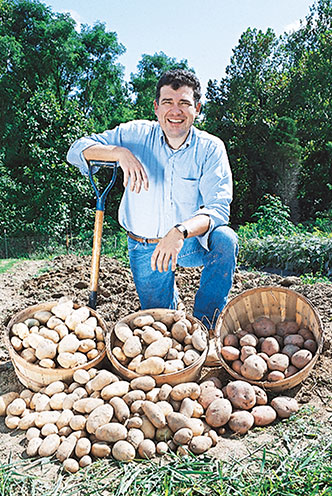
The incrediblePOTATO
What is a potato? Definition
A potato is an underground starchy tuber grown and consumed by people around the world. Globally, it ranks as one of the most important food crops.
A Brief Potato History
The potato, Solanum tuberosum, is a root vegetable whose origins can be traced back to southern Peru and northwestern Bolivia. Domestication of potatoes occurred 7,000-10,000 years ago.
There are up to 180 species of potatoes that exist in the wild, with a native range that extends from southern Chile to southwestern USA. Several are eaten in their native lands; however, many are too bitter and contain toxins that render them inedible. Despite this, many species are used in breeding to transfer traits for disease and pest resistance. The Peruvian Andes is the center of potato genetic diversity. Most of our modern day varieties originate from the lowlands of Chile.
The potato did not follow a direct route to North America. It was first introduced to European explorers in the mid-16th century. These Europeans then introduced it to North America towards the end of the 16th century.
From centuries of selections and more recent breeding efforts, over 4,000 varieties of potatoes exist today. China, India, Russia, Ukraine and the USA (in that order) are the top producers of potatoes in the world. Per capita consumption is highest in eastern and northern Europe with Belarus leading the way.
Potato varieties have a wide range of skin colors including white, tan, yellow, pink, red, purple and blue. The flesh also has a wide range of colors including white, yellow, pink, purple and blue.
Potatoes are prepared in a variety of ways including roasted, fried, boiled, steamed and baked. Dishes made with them include stuffed patties, dumplings, casseroles, pancakes, salads and stews.
Like peppers, tomatoes and eggplants, potatoes are a member of the nightshade family in the genus Solanum. Many members of this genus contain dangerous glycoalkaloids that can be found in the vegetation and fruiting parts of the plant. The potato tuber contains negligible levels of these compounds; however, if exposed to sunlight for a prolonged period they can increase to levels that may be harmful to human health. You will see throughout this guide we take steps to shelter the tubers from exposure to sunlight in both the growing stage and storage stage.

Types of Potatoes
The potatoes for sale in the grocery store represent only a very small portion of the types and varieties of potatoes available. The marketplace is not geared to offer you 20-30 different varieties. The best way to experience the diversity of potatoes is to grow your own.
Potatoes can be placed in three general categories depending on what type of flesh the tubers have: starchy, waxy or all purpose. Although they have many different skin and flesh colors, these different colors do not indicate potato type--skin and flesh color cuts across the board of potato types. Fingerlings and low glycemic varieties are subcategories.
-
Starchy
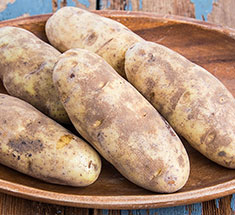
Starchy varieties have white to pale yellow flesh that has a dry, light, fluffy texture when cooked. They break down during the cooking process and do not retain their shape. Excellent for baked potatoes, light and fluffy mashed potatoes and french fries. Russet potatoes are the most common starchy varieties. They are medium to large potatoes with a russeted brown netted skin. 'Russet Burbank' is a classic high starch variety.
-
Waxy
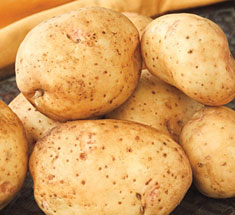
Waxy potatoes have a firm creamy texture, high moisture content and hold their shape when cooked. They work great for boiling, roasting and baking when you want the potato to retain its shape. They are also good for soups and potato salads. 'Carola', a favorite among home gardeners, is an old German waxy variety that stands the test of time.
-
All Purpose
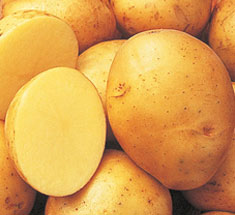
All-purpose potatoes come in many skin colors and flesh colors. They have moderate starches and moisture and are good for most culinary uses. Think of all-purpose potatoes as the ultimate workhorse. As the middle of the road potato, all-purpose potatoes usually suffice as a substitute for any starchy or waxy potato recipe. The most well-known is 'Yukon Gold'.
-
Fingerlings
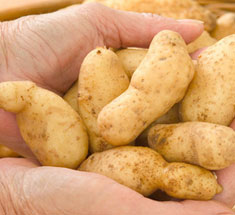
Fingerlings are usually 2-4 inches long and have various skin colors including tan, red, yellow and purple. Flesh color varies as well. They have a firm, waxy texture and buttery, nutty and earthy flavors. Pan frying and roasting are great ways to feature their buttery flavor. They also work great in potato salads and stews. 'French Fingerling' and 'Russian Banana' are well-known varieties.
-
Low Glycemic Index Varieties
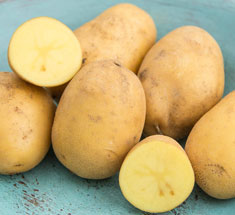
Potatoes have long been on the list of high glycemic foods. High glycemic foods are digested quickly and can cause a big spike in blood sugar and insulin levels. Low glycemic index (GI) foods digest slowly and do not cause a large spike. Recent research has revealed the variety 'Nicola' is a low GI potato.
Potato Nutrition Facts
Potatoes are packed with nutrients. Among them are fiber and antioxidants. The fiber helps control cholesterol and blood sugar levels, provide good bacteria for gut health and otherwise promote digestion and regularity. If your doctor has advised eating food with a low glycemic index to prevent spikes in blood sugar or glucose levels, choose a potato variety identified as low glycemic. The antioxidants in potatoes help prevent cell damage, which is believed to help reduce the risk of heart disease and cancer. In a potato, the highest levels of antioxidants are in the skins, so be sure to eat the skins. Among the different varieties of potatoes, the highest levels of antioxidant are found in those with color, such as purple potatoes. Potatoes are also a source of vitamins C and B6, potassium, magnesium and even calcium. Potatoes often get a bad rap, but in addition to their nutritional value, they are actually a fat- and cholesterol-free food—it's how you cook them or dress them that causes problems.
How to Grow Potatoes
1 Selecting potatoes
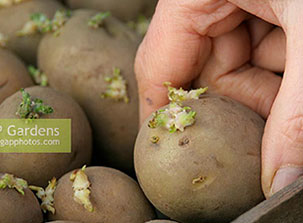 When buying potatoes for planting, whether conventional or certified organic, always make sure they are certified disease-free potatoes from a reputable source. Avoid grocery-store potatoes, which are often treated with a chemical that inhibits sprouting.
When buying potatoes for planting, whether conventional or certified organic, always make sure they are certified disease-free potatoes from a reputable source. Avoid grocery-store potatoes, which are often treated with a chemical that inhibits sprouting.
2 Deciding when and where to plant
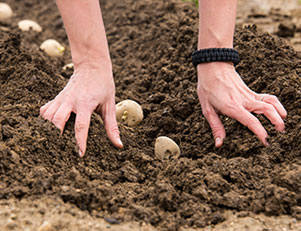 Potato plants grow best in loose soil that is well drained and located in full sun. Unless you live in a warm climate, do not follow the adage of planting potatoes on St. Patrick's Day. If planted too early, wet soil will delay emergence or cause the tubers to rot. The soil temperature should be 50°F or higher, often reached two to three weeks before the last spring frost. In many areas, the general rule is potatoes can be planted when dandelions start to bloom.
Potato plants grow best in loose soil that is well drained and located in full sun. Unless you live in a warm climate, do not follow the adage of planting potatoes on St. Patrick's Day. If planted too early, wet soil will delay emergence or cause the tubers to rot. The soil temperature should be 50°F or higher, often reached two to three weeks before the last spring frost. In many areas, the general rule is potatoes can be planted when dandelions start to bloom.
3 How to sprout potatoes
 Green sprouting, or chitting, warms seed potatoes to encourage sprouting. Although not required, it does promote quicker soil emergence, earlier harvest and may increase yields. It also lets you get a head start on the gardening season by giving you a task that can be done inside while the weather is still too inclement for planting. Follow these steps to green sprout:
Green sprouting, or chitting, warms seed potatoes to encourage sprouting. Although not required, it does promote quicker soil emergence, earlier harvest and may increase yields. It also lets you get a head start on the gardening season by giving you a task that can be done inside while the weather is still too inclement for planting. Follow these steps to green sprout:
- Four to six weeks before planting, place your potatoes in a paper bag and store them in a warm, dark location.
- Two weeks later, bring the potatoes into a warm, well-lit location but out of direct sunlight. This will stimulate the potatoes to sprout and could take an additional two to four weeks.
Watch how to divide and plant potatoes
4 How to Plant Potatoes
- Whether green sprouted or not, cut large tubers with multiple eyes or sprouts into several pieces a few days before planting. Eyes are the small indentations where the sprouts emerge. Each cut piece should contain at least two eyes or two sets of sprouts. Small potatoes can be planted whole.
- Plant seed potatoes 2 inches deep and space 12 inches apart with 30-36 inches between rows. If you plan to harvest new potatoes only, space them 6 inches apart.

Protecting plants from frost

Potato plants are fairly frost tolerant; however, a hard freeze can burn them to the ground. They can recover, but you will lose time and yield. If a hard freeze is predicted, protect your plants with frost blankets or something similar.
5 Fertilizing
Having a sample of your garden soil tested for fertility is a good way to start your growing season and will give you a baseline for fertilization. Potatoes prefer a well-drained soil with a pH range of 6-7. They are adaptable, however, and can be grown outside this range.
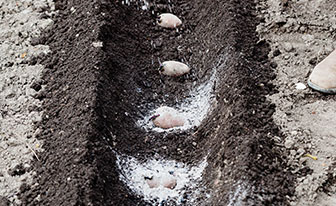
Fertilize at time of planting

Fertilize again when flowers appear
Potatoes can be fertilized at time of planting or just as their sprouts emerge from the ground and again at midseason just as the potatoes begin to flower. Gurney's® Potato Food-Fertilizer is a good blend. It not only provides the nutrients potatoes need, it feeds the microbes that unlock other nutrients in the soil.
6 Hilling
Once plants are 8-10 inches tall, it is common practice to pull soil up onto each potato plant from both sides of the row. This can be done every two to three weeks until the hill is 8-12 inches tall. Hilling accomplishes several tasks. It helps with weed control and keeps tubers covered so they do not turn green from direct sunlight. For indeterminate varieties, it will boost yields since the covered stems can produce more potatoes. Determinate potatoes only need a few inches of soil when hilling to make sure the tubers are covered and protected from sun exposure.
Mulching the potatoes is a good practice especially if you do not intend to hill your potatoes. The mulch helps keep consistent moisture and does not allow sunlight to hit tubers that are at the surface. The sunlight will turn the skin green, and this is not beneficial to you or the tuber.
Maintaining consistent moisture will benefit both the quality and quantity of potatoes harvested. Proper moisture is particularly important when tubers are forming. They start forming about the same time as the plants start to bloom. Avoid overly wet conditions as this could lead to disease problems.
Once potatoes have had their final mulching or hilling, the main task is to keep them well watered and free of pests until a few weeks before harvest time.
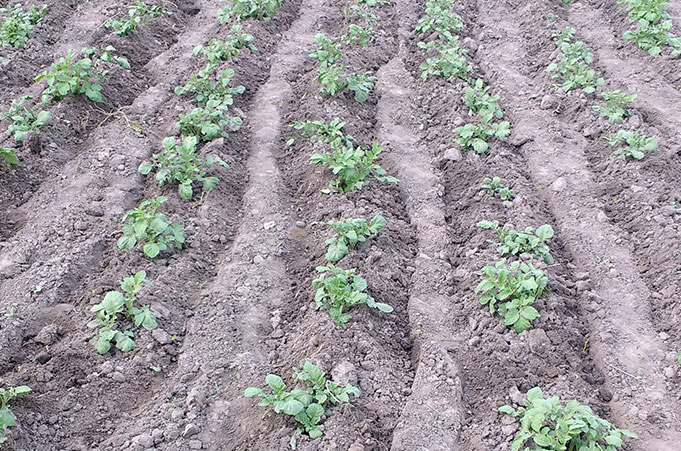
Hilling helps control weeds and keeps tubers covered so they do not turn green from exposure to the sun.
7 Growing potatoes in containers and raised beds
Growing potatoes in containers is an excellent way to produce clean, blemish-free tubers from healthy plants. It is an ideal method if you have limited space or want to get a jump on the season. Many of the same guidelines for growing potatoes in the ground pertain to container growing. Short season determinate varieties work best in containers; however, any variety will work. I grow most of my potatoes in ground although I do plant a few containers of red potatoes for harvesting small new potatoes early in the season. Container-grown potatoes seem to mature faster since the soil warms quicker.
Select a large container: 15-20 gallon pots or grow bags are a good size. Use a good, free draining potting soil. You can amend the potting soil with some compost if it is available. Do not use garden soil. Fill the container with 4-6 inches of soil. Place 4 or 5 cut potato pieces or small potatoes equally spaced on top of the soil. Once potatoes are placed, top off the pot and bring the soil level up just below the pot rim. Work some fertilizer into the mix and water.
Once the potatoes start growing, keep the mix consistently moist. Since they are in a pot and being watered often, nutrients leach out of the pot. To counteract this challenge of fertilizing potatoes in containers, use a diluted liquid fertilizer every two weeks or sprinkle more granular fertilizer once a month. Hilling is unnecessary; however, mulching may be helpful to maintain moisture.
Watch how to harvest potatoes from containers
Watch how to divide and plant potatoes

Protecting plants from frost
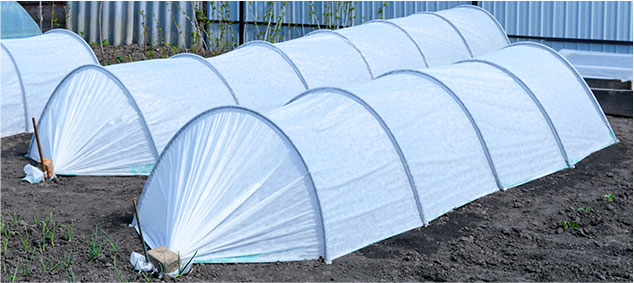
Potato plants are fairly frost tolerant; however, a hard freeze can burn them to the ground. They can recover, but you will lose time and yield. If a hard freeze is predicted, protect your plants with frost blankets or something similar.
A high-quality fertilizer like Gurney's® Potato Food-Fertilizer helps ensure successful yields.

Hilling helps control weeds and keeps tubers covered so they do not turn green from exposure to the sun.
Watch how to harvest potatoes from containers
Growing in raised beds is very similar to growing in a container. One important consideration when planting in a raised bed is soil quality. If it is light and fluffy, the potatoes can be planted 4-6 inches deep. If it is more like garden soil, stick to planting 2 inches deep. Other than that, follow the standard guidelines for growing potatoes.
8 Harvesting potatoes
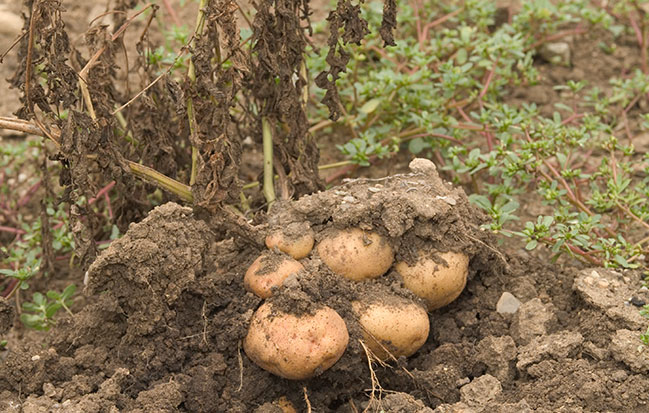 For new small potatoes, you can start checking roughly three weeks after the plants start flowering. To do this, carefully pull soil away from the plant near where the stem meets the soil. Start harvesting when the tubers are about the size of a golf ball. For storage purposes, potatoes are ready to harvest two weeks after the vines turn yellow and die down. This period in the ground after plants die allows the skin on the potatoes to cure or toughen and enables the potatoes to store better without the skin getting blemished.
For new small potatoes, you can start checking roughly three weeks after the plants start flowering. To do this, carefully pull soil away from the plant near where the stem meets the soil. Start harvesting when the tubers are about the size of a golf ball. For storage purposes, potatoes are ready to harvest two weeks after the vines turn yellow and die down. This period in the ground after plants die allows the skin on the potatoes to cure or toughen and enables the potatoes to store better without the skin getting blemished.
When your potatoes are ready to dig, use a shovel or digging fork to loosen soil on either side of the row, starting about 12 inches out from the plant base. Push your tool into the soil at an angle towards the center of the row, getting underneath the potato plant. Once the tool is inserted, gently use leverage to pry up and loosen the soil. When soil is loosened around the plant, reinsert your tool and lift up to expose the tubers. Do this several times and sift through the soil until you find all the potatoes. As you get a feel for the location of the tubers, adjust you digging distance and depth accordingly.
Potatoes that have been damaged by the digging process should be eaten right away since they will rot quickly in storage.
After harvesting, do not wash the potatoes before storing; however, you can brush off the dirt. Store potatoes in a cool, humid and dark place. The ideal temperature range is 42-50°F. A warm environment encourages sprouting. If the environment is too cold, tissue damage will occur. A root cellar would be perfect; however, since most of us do not have one, try a cool corner of the basement or unheated garage.
Potato Pests and Diseases
Potatoes are generally an easy crop to raise; however, there are a few pests and diseases that the home gardener should keep in mind since a few can have dramatic effects on plant health and yield.
Crop rotation is a good practice to help avoid several pests and diseases. Always plant high quality seed potatoes and never plant potatoes in the same spot as they were grown the year prior. Avoid planting them where other members in the nightshade family have been planted. These include tomatoes, peppers, eggplants and tomatillos. Also, try to keep weeds in the nightshade family out of the garden and surrounding areas. Jimson weed, nightshade, horse nettle and ground cherries are some of the main weeds to watch for.
Insects
The Colorado potato beetle is the most common pest on potatoes and quite easy to spot when it is feeding. Both larvae and adults feed on potatoes and can completely defoliate the plants. There are several strategies the home gardener can use to prevent damage from this pest.
Exclusion is a good first course. Covering the row with Super-Lite Insect Barrier will keep the beetles and other pests from getting on the plants. Another good option is Surround at Home® Kaolin Clay Crop Protectant. When these fine clay particles are sprayed onto the plant, insects spend all their time being irritated and try to clean themselves instead of eating your plants.
In the small garden you can physically pick the larvae and adults off the plants. If you see egg masses under the leaves, you can pick them off, too. To prevent eggs from hatching, Oil-Away™ Supreme Insecticidal Oil can be sprayed to smother eggs without harming beneficial insects. For larvae and adults, Pyola® Insect Spray is a good option for knocking them back. Shield-All Plus™ Pest & Disease Control will address insects and disease problems.
Flea beetles are another nuisance. Often their damage is superficial and does not affect yield; however, if numbers get large, they can do some serious damage. Most of the methods mentioned above for the Colorado potato beetle work for flea beetles as well.
hoppers are sucking insects, and their damage is first noticed as pale coloring along the leaf veins, followed by browning of the leaf tips. If not controlled, they can reduce potato production. It is best to deal with them early. The same controls for Colorado potato beetle can be used for potato leaf hoppers.
Aphids are another sucking insect that can do great damage to your potato crop. As with the leafhoppers, it is much easier to deal with them early before crop damage and a population explosion that comes with warmer weather.

The Colorado potato beetle can completely defoliate plants.

Browning leaves are a sign of potato leaf hoppers.

Aphids can also do great damage to your potatoes.

Damage from flea beetles is superficial unless there is an infestation.
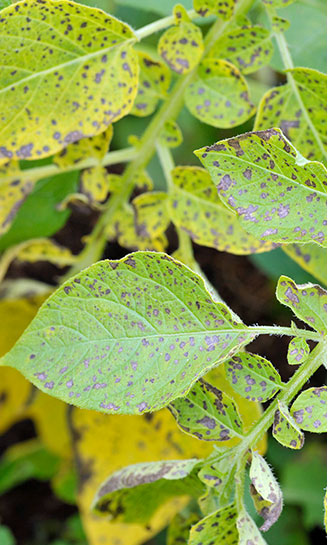
Late Blight
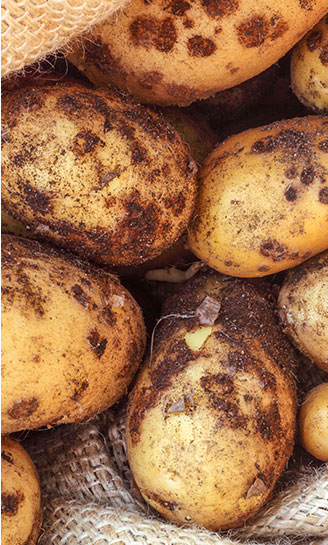
Scab
Diseases
Late Blight is a fungal-like disease of historic significance since it is the main factor that led to the Irish Potato Famine. It first appears on the leaves as dark spots surrounded by a yellow halo. In cool, damp weather the disease will quickly spread throughout the plant and eventually kill it. Late Blight can also affect the tubers. Only plant Certified Seed Potatoes, practice good sanitation in the garden and do not allow any weeds, especially those in the nightshade family, to grow near your garden. A three-to four-year crop rotation is also a good idea. Soap-Shield® Flowable Liquid Copper Fungicide can help prevent disease from establishing itself and may help control Late Blight.
Early Blight, a soilborne fungal pathogen, develops on the leaves as the plant is maturing. Symptoms first appear on lower leaves. Dark sunken spots enlarge to reveal concentric rings within the spot. Severe infections can affect yield. Good garden sanitation coupled with good airflow can help avoid the disease. Preventive sprays include Garden Sentinel™ Organic Broad-Spectrum Biofungicide and Soap-Shield® Flowable Liquid Copper Fungicide.
Scab, a common disease in many areas, is caused by a bacterium. It appears on the tuber as brown raised spots with a corky texture. The best defense is to raise scab-tolerant varieties. Other cultural practices can help; for example, maintaining a low soil pH and consistent soil moisture at tuber formation helps prevent the disease.
For identification and control measures of other pests and diseases in your area, consult your local county extension agents. They often have published articles related to these matters.
Are You Ready to Start?
Growing potatoes! They are more than boring old lumps of brown that come out of the soil. They are jewels of the earth that come in an array of skin and flesh colors. Unearthing these earthly beauties is one of the great thrills of growing your own. Shop our wide selection of potatoes. I am sure we have a selection or two that will strike your fancy.






 Gardens Alive! & Supplies
Gardens Alive! & Supplies





